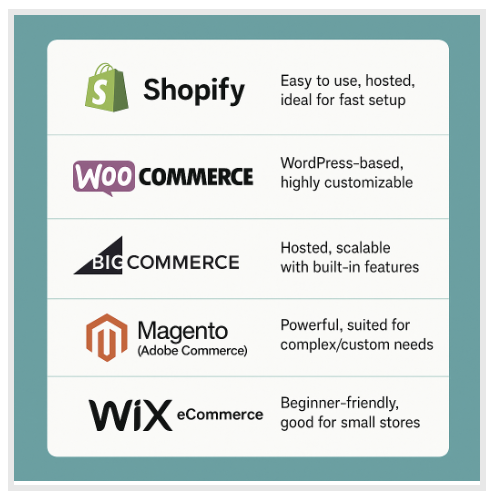Table of Contents
Listen to article
While online shopping is far from new, its significance has grown since the pandemic, permanently shifting retail toward digital-first experiences.
With ecommerce sales in 2024 accounting for 16.1% of total sales, companies must create a digital storefront to stay competitive and reach a wider audience. And not just any online store—a website that’s capable of standing out in a crowded market.
At the forefront of online success is custom ecommerce web development, or as many see it, the key to creating a scalable, secure, and user-centric online store.
And our goal?
We’re here to guide you through the world of ecommerce website development—covering key considerations, what to expect from the process, and why outsourcing is a great option for your business.
What is ecommerce website development?
Ecommerce website development is the process of building an online platform where businesses can sell products or services, manage transactions, and provide a seamless shopping experience for customers. This process involves both front-end and back-end development, in which ecommerce web developers use advanced technologies and techniques to ensure the website has a strong foundation and a secure, user-friendly interface.
Think of it like this: a poorly built website is like a disorganized room—hard to find what you need, frustrating to navigate, and makes you want to leave immediately. A well-designed website, on the other hand, has that “wow” effect—clean, aesthetic, and enjoyable to explore, essentially supporting long-term growth.
As we’ll see below, there are various factors that make up an effective web development process, covering everything from website design and product catalog setup to payment integration, SEO, and mobile responsiveness.
Factors Included in eCommerce Web Development
Ecommerce software development goes beyond just building a website—it involves developing the systems, applications, and integrations that power your entire online business. From secure transactions to smooth operations and user-centric experiences, every layer must be carefully designed.
Key considerations include:
- Website design: From buttons and scroll bars to the color, font, and style, web designers create websites that are on-brand and user-friendly to help companies improve conversions.
- Product catalog: Development teams create professional product catalogs to showcase products and services in an organized, visually appealing way to help website visitors browse, compare, and make informed purchase decisions.
- Shopping cart: Developers use pre-built ecommerce platforms—like Shopify or WooCommerce—or create a custom shopping cart from scratch to enable customers to select, store, and manage items before making a purchase.
- Payment gateway integration: To enable secure and seamless online transactions, ecommerce web developers integrate payment gateways that handle everything from card validation to fraud detection, ensuring payments are processed quickly and safely.
- Security: Developers follow security best practices—such as data encryption and regular security audits—to comply with industry-specific regulations, protect websites from unauthorized access, and foster trust among customers.
- Search engine optimization (SEO): SEO services improve your website’s visibility on search engines like Google and Yahoo, helping users find your website and increasing the chances of converting visits into leads or sales. Read this comprehensive blog for insights into online marketing strategies for small businesses.
- Mobile responsiveness: An important aspect of web development is mobile responsiveness, as it ensures your website functions on various platforms—helping you attract the millions of people shopping on their mobile devices.
- Customer service: There are a number of ways to integrate customer service into custom ecommerce website development. For instance, an increasing number of companies are adopting AI-driven chatbots to provide personalized interactions and 24/7 support. So much so that the global AI chatbot market is projected to reach a value of US$46.641 billion by 2029.
- AI-powered recommendation systems: These systems enhance the shopping experience by delivering personalized product suggestions. Similarly, features like dynamic pricing algorithms and visual search tools boost customer engagement, satisfaction, and sales.

The Current State of the eCommerce Market
If there’s one thing we know, it’s that the ecommerce market will never go out of business. In 2024, global ecommerce sales amounted to over seven trillion U.S. dollars and are expected to exceed 10.4 trillion U.S. dollars by 2028.
However, this market is far from stagnant. In fact, 75% of consumers tried a new shopping behavior during the pandemic, highlighting the importance of adaptability in meeting evolving customer expectations.
As a whole, the retail sector is becoming increasingly digital—what was once limited to in-store shopping has transformed into a mobile-first experience. In the fourth quarter of 2024, smartphones constituted around 78% of retail site traffic globally, responsible for generating 68% of online shopping orders.
This not only means that consumers can enjoy cross-border shopping but also that companies now have the opportunity to reach a new market that may have been impossible before.
With about 1.09 billion websites on the internet, companies must know how to develop an ecommerce website that stands out from the crowd—something possible with AI personalization.
Today, 71% of consumers expect companies to deliver personalized interactions. While there are various ways to do this, AI technologies are transforming how companies navigate the digital realm—and how they meet rising consumer expectations.
Take Amazon, for example—one of the leading examples of a thriving ecommerce platform. Amazon’s AI-driven personalization system recommends products based on user activity, which significantly boosts sales. Over time, an increasing number of brands are expected to adopt similar approaches.
Overall, AI is projected to unlock between $240 billion and $390 billion in economic value for retailers.
In summary, companies must consider new trends and consumer behaviors to stay competitive in the digital realm. To overcome potential challenges such as increased competition, rising customer acquisition costs, and heightened expectations for fast, frictionless user experiences, custom ecommerce website development is required.
Key Considerations Before You Start Developing an eCommerce Website
Every aspect of your website must be carefully planned to ensure it helps you overcome real-world challenges and achieve desired outcomes. While ecommerce website development companies guide you through this process, you should be aware of the key considerations for laying a solid foundation before building your site.
This includes:
- Selecting a business model: What ecommerce structure best fits your goals—B2C, B2B, subscription, or a hybrid approach?
- Understanding your target audience: What are the demographics and purchasing behaviors of your target audience?
- Defining your unique selling proposition: What sets your company apart from competitors?
- Choosing between hosted platforms or custom solutions: What level of flexibility, control, and scalability does your ecommerce business need now and in the future?
- Creating a plan for mobile responsiveness: How will your website adapt to different screen sizes to cater to a larger audience?
- Identifying essential integrations: What tools and features does your website require—payment gateways, inventory management systems, customer relationship tools?
By planning these considerations ahead of time, you can prevent costly revisions down the road.
Understanding the Process of Developing an eCommerce Website
So what does ecommerce web development entail? What should my company expect?
Keep reading to learn the 5 key stages of custom ecommerce website development—and the importance of post-launch optimization.
1. Shaping Your Business Concept
For successful online store development, this process must begin with a well-defined and validated business concept, as this sets the tone for the rest of your project.
During this phase, you and your development company must answer the questions listed above—defining factors such as your target audience, unique selling proposition, and expected goals.
The answers to these factors should not be random but rather based on current trends, competitor analysis, and an understanding of customer pain points. You can then finalize your business concept by performing keyword research, evaluating Google trends, and gathering survey responses to confirm genuine demand.
These insights will directly influence product strategy, pricing, and the overall customer experience.
2. Planning and Strategy
Building on the business concept defined in the previous stage, you must then develop a clear plan to effectively launch a functional—and successful—ecommerce site.
Your ecommerce website development company will create a detailed roadmap, outlining the customer journey, required features and design elements, and milestones.
An important part of this stage is establishing a realistic budget and timeline that covers everything from development to platform maintenance and marketing costs.
3. Choosing the Right eCommerce Platform
Selecting the right platform is crucial for functionality, scalability, and ease of use—not only for your current needs, but also with your future growth in mind.
There are many ecommerce platforms available on the market, meaning you must consider factors like customization, third-party integrations, and long-term business needs to determine the best option for you.
For instance, Shopify is among the most popular ecommerce platforms. Its flexibility and ease of use are great for businesses of all sizes, from startups to large enterprises.
Wix eCommerce, on the other hand, appeals to companies with smaller product lines, offering affordable features and an intuitive drag-and-drop builder.
See the image below for a list of popular ecommerce platforms:

4. Designing the User Experience
Did you know that 35% of money is left on the table because of bad UX in ecommerce?
This statistic makes it crystal clear that creating a user-centric design that’s simple, consistent, and accessible is a key aspect of ecommerce app development.
To accomplish this, your ecommerce web developer should create a mobile-first, responsive layout with intuitive navigation, fast load times, and clear CTAs—all while ensuring brand consistency across the site.
Tools like Sketch and Figma help maintain a balance between attractive design and functional efficiency, ultimately driving engagement and conversion.
5. Developing and Launching Your eCommerce Site
At this stage, developers must determine the best programming languages for ecommerce, considering the unique requirements for both front-end and back-end development. Factors like integrations with payment gateways, inventory systems, and shipping tools must be considered, as these are vital components of an ecommerce website.
Wireframes play an important role in B2C and B2B ecommerce website development, as they help plan the site’s layout, navigation, and user experience before development begins.
Rigorous testing must also be performed to ensure fast loading times, mobile responsiveness, and a smooth, error-free user experience.
Companies can also consider doing a soft launch to gather feedback and make final adjustments before the full public rollout.
Post-Launch Optimization
Building a website that delivers real business value doesn’t end after development. You can use tools like Google Analytics and heatmaps to track the performance of the website and understand user behavior. Running A/B tests is also valuable in improving key pages and using customer feedback to refine UX.
Post-launch ecommerce SEO audits are another effective strategy that helps companies fix technical issues, optimize content, and improve search visibility. By implementing growth strategies—like content marketing, upselling, and automation—you can drive sustained traffic, increase conversions, and maximize long-term revenue.
Why Should You Outsource eCommerce Website Development Work
In-house development and marketing can be expensive—requiring extensive internal resources and ongoing investments in talent, tools, and infrastructure. Even more, your project may require specialized skills that exceed your team’s current capabilities, potentially delaying your timeline until an in-house expert is hired.
On the other hand, partnering with an eCommerce website development company gives you access to experienced professionals, faster turnaround times, and flexible support—without the overhead of hiring and managing a full in-house team.
With Scopic’s ecommerce web development services, we use the latest technologies to build advanced websites, all while reducing overhead, minimizing risk, and freeing you to focus on business strategy.
Scopic is the Right Partner for Your eCommerce Website Development
Scopic’s web development services cover everything from UX/UI design and secure integrations to SEO-ready architecture and digital marketing. These solutions are backed by proven results that help businesses grow online, attract more customers, and improve ROI.
Our solutions are:
1. Built to Scale — Right from the Start
Our custom ecommerce platforms grow with your business—whether you’re serving 100 customers or 100,000. No more rebuilds. No wasted investment.
2. Full Stack
No fragmented vendors. From design and development to security and SEO—you get a single team aligned with your goals, and a single point of contact.
3. Trusted by 1,000+ Clients Worldwide
With experience across 15+ industries, including healthcare, fintech, and B2B manufacturing, we understand your needs—and we act fast.
Our scalable, tailored solutions for the ecommerce industry have helped a number of businesses achieve their short- and long-term goals. With extensive cross-industry experience and a flexible approach, we’re a reliable partner for both startups and enterprises alike.
However, there’s no better way to understand our experience, industry-specific solutions, and results than by evaluating real stories from satisfied clients and reading their testimonials.
Conclusion
Ecommerce website development is the key to staying ahead in the constantly evolving digital realm. As more consumers turn to online shopping, make sure you have a unique digital storefront that offers personalized experiences, seamless navigation, and efficient transaction processes.
At Scopic, we’re passionate about creating custom solutions that address real-world challenges and effectively engage your target audience. With years of experience in online store development, we deliver user-friendly ecommerce platforms designed to drive growth, increase conversions, and enhance your brand presence.
Contact us today to learn more about our services.
FAQs about eCommerce Website Development
How much does it cost to develop an eCommerce website?
The price of custom ecommerce website development depends on the complexity of the project and the desired features. While simple projects may cost a few thousand dollars, large enterprise marketplaces can cost 150,000+.
Contact us today for a free quote on your next project.
How long does it take to build an eCommerce website?
Building an ecommerce website can take anywhere from a few weeks to 6+ months, depending on the complexity of the project.
Which is the best platform for an eCommerce website?
The best platform for an ecommerce website depends on your specific business needs, with popular options including Shopify, BigCommerce, and Wix.
Is SEO important for an eCommerce website?
Yes, SEO is crucial for an ecommerce website as it helps improve search engine visibility, drive organic traffic, and increase conversions.
Read our comprehensive blog to learn how to grow an ecommerce business with marketplace SEO.
What is the difference between a hosted and a self-hosted platform?
A hosted platform is a service where the provider manages hosting, security, and maintenance, while a self-hosted platform gives you full control over hosting and server management. Our team will evaluate your specific business requirements before recommending the right option for you.
Can I scale my eCommerce website over time?
Yes, you can scale your ecommerce website over time by upgrading your hosting, adding new features, integrating with third-party tools, and optimizing performance. Our team will develop your solution with scalability in mind, ensuring it grows alongside your business.

About eCommerce Website Development Guide
This guide was authored by Baily Ramsey, and reviewed by Enedia Oshafi, Engineering Operations Manager at Scopic.
Scopic provides quality and informative content, powered by our deep-rooted expertise in software development. Our team of content writers and experts have great knowledge in the latest software technologies, allowing them to break down even the most complex topics in the field. They also know how to tackle topics from a wide range of industries, capture their essence, and deliver valuable content across all digital platforms.
Note: This blog’s images are sourced from Freepik.





